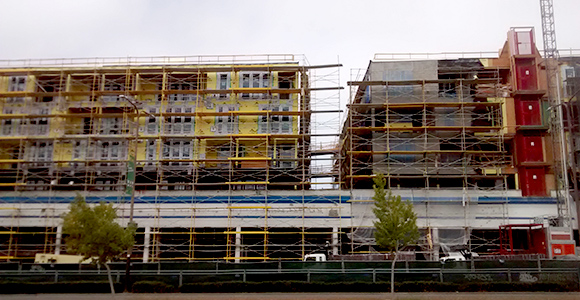
Berkeley apartment construction (Photo Credit: Mike Linksvayer/Flickr)
Even before the governor pledged this week to take action (finally) on housing after the summer recess, legislative leaders were already speaking proudly about the ideas being discussed in the Capitol, with the Assembly Speaker saying in April that his members were “working on numerous fronts” to support Californians suffering from rising housing costs, while the Senate President pro Tem claimed in June that his house had already “passed a package of consequential legislation aimed at alleviating the state’s growing housing crisis.”
The three leaders issued a joint statement ahead of yesterday’s cap and trade vote outlining the broad strokes of a deal they hope to strike before September: “It will include a general obligation bond, a permanent funding source for affordable housing and regulatory reform,” they said, noting that this “comprehensive approach does what's long been needed in California—build new homes and improve access to housing.”
But will it really?
If this new “deal” is based on the ideas currently working their way through the Legislature, I’m not so sure. (Here's one reason why.) The truth is, though, no one really knows—because with the state facing a shortage of at least one million housing units, it’s hard to tell how much of the gap can actually be closed by different policy proposals. Much-needed funding bills and a housing bond will produce a certain number of units, sure. But “regulatory reform?” That is a great unknown.
That’s why the state desperately needs a ranking system we can all agree on for gauging the actual impact of different housing proposals—especially any bills in a housing package touted as a solution to the crisis. (Check out a first draft here.)
What’s clear, right now, is that the legislation currently moving through the Capitol is not yet up to the task. CA Economic Summit leaders offered a sobering assessment last week of the 50-some active housing bills, saying they were “insufficient” to address the housing crisis—and arguing that “no comprehensive package has emerged…that will make the full range of policy changes necessary to move the needle on housing.”
Returning to its One Million Homes Framework, an “all of the above” strategy for expanding housing supplies, the Summit highlighted the lack of real fiscal incentives in this year’s bills (money for housing-related infrastructure, say) that would get more communities to say “yes” to housing. The Summit also emphasized the need for a net reduction in the costs of housing development to get more builders to build.
Legislative leaders—and now the governor—are now telling us they’ve got this covered. They’ve made housing a priority, they’re moving a bunch of bills, and they’re targeting some of the right policy levers.
The question is, how can we be sure the solution they come up with will match the scale of the crisis?
Among some housing experts and builders, there is growing concern that this year’s proposals won’t do enough to solve the crisis. Some will add new state fees and mandates that will increase housing costs for working families. Some will spend money but won’t accomplish as much as they could, since they avoid grappling with the enormous financial uncertainty hanging over all housing development—and the strong likelihood that NIMBYs, particularly in wealthier, whiter, more expensive areas, will abuse the California Environmental Quality Act to kill projects, especially those for low-income households.
Others are simply aimed at worthy policy objectives, like climate change or open space mandates, but with a one-size-fits-all approach that ignores very significant regional differences.
Housing is a complicated issue, and it’s taken decades of chronic underproduction going back to at least the 1980s—coupled with ever-escalating costs—to create the current crisis. Sifting through even a shortlist of bills in a potential housing package is a daunting and confusing task, with the inevitably diffuse, overlapping, and conflicting nature of these ideas.
That’s why California needs a new tracking tool that can be used to summarize and rank existing (and future) state housing policy proposals. This tool should allow leaders in every region to assess whether a package produced by the governor and Legislature will actually increase housing production and make housing more affordable to Californians. It should also allow them to more quickly dismiss proposals that “do harm” by increasing housing costs or discouraging production.
This is just a start, and feedback is certainly welcome. This tool is already being tested this summer by a coalition of housing groups in the Bay Area. Other regions are encouraged to apply it as part of your own consideration of housing policy proposals.
Our state leaders have made a pledge to take on California’s housing affordability crisis. That’s the good news. But now we need to work together to make sure they do it right—recognizing the multiple goals and policies of different stakeholders, while remaining focused on producing more housing, more quickly, for more Californians.
Let’s start by ranking these ideas to see what they actually do.
Jennifer Hernandez is a partner at Holland & Knight and a member of the CA Fwd Leadership Council.

